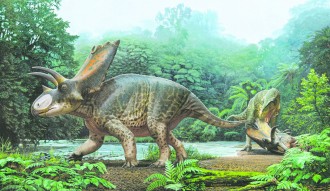The Young Scientist!
The Young Scientist!
November 16, 2022By AILEEN O’CATHERINE

A dinosaur discovery made in New Mexico’s Bisti badlands in the 1970s has recently been discovered to be a link in the evolutionary chain of a kind of dinosaur similar to the well-known triceratops. In the 1970s, scientists from the University of Arizona found a dinosaur skull fossil in the Bisti/De-Na-Zin Wilderness of New Mexico. In the early 2000s, the skull fossil was taken to the New Mexico Museum of Natural History in Albuquerque, where teams carefully cleaned the skull and made it more stable. After working on the skull for a few years, the team realized it wasn’t from a pentaceratops as they had originally thought but was instead a dinosaur no one knew about, something scientists term a new genus.
New Mexico Museum of Natural History and Science (NMMNHS) curator Dr. Spencer Lucas and Research Associate Sebastian Dalman, as well as Dr. Steven E. Jasinski from Harrisburg University, announced their discovery, which was named Bisticeratops froeseorum (pronounced BISS-tie-SAYR-uh-tops frose-e-or-um). The dinosaur was named after the place it was found, the Bisti/De-Na-Zin Wilderness, south of Farmington, and for the Froese family of the musical group Tangerine Dream, which is one of Dalman’s favorite bands.
The new dinosaur is a Ceratops, meaning it is horn-faced. The triceratops had three horns and the pentaceratops had five horns, but bisticeratops froeseorum had two horns. The horns and jaw of the bisticeratops were constructed differently than those of other ceratops dinosaurs, leading scientists to conclude this was a new kind of dinosaur.
Bisticeratops was smaller than triceratops, about 5 to 6 meters long (16 to 20 feet) and about 2 to 4 tons in weight, making it about the same size as a female African elephant. Like triceratops, it was an herbivore or plant eater.
Scientists are excited about the discovery because Bisticeratops lived about 7 million years before triceratops and other similar ceratops cousins. Horned dinosaurs were successful about 10 million years before dinosaurs went extinct and were very successful in North America. Bisticeratops was different than dinosaurs found farther north in Wyoming and Canada. Scientists wonder if Bisticeratops was part of a southern group of dinosaurs, and if there were regional differences in dinosaurs in this time period.
The area where this dinosaur lived was made up of jungle and swamps near a seacoast that submerged the area we now know of as northwestern New Mexico. The fossil skull shows bite marks from what was probably a tyrannosaurid, the largest of which was Tyrannosaurus rex.
Fossil discoveries like that of the Bisticeratops help scientists develop a clearer idea of what species lived in that time period, and how they may have interacted with each other.
More information: media.newmexicoculture.org/press_releases.php?action=d




